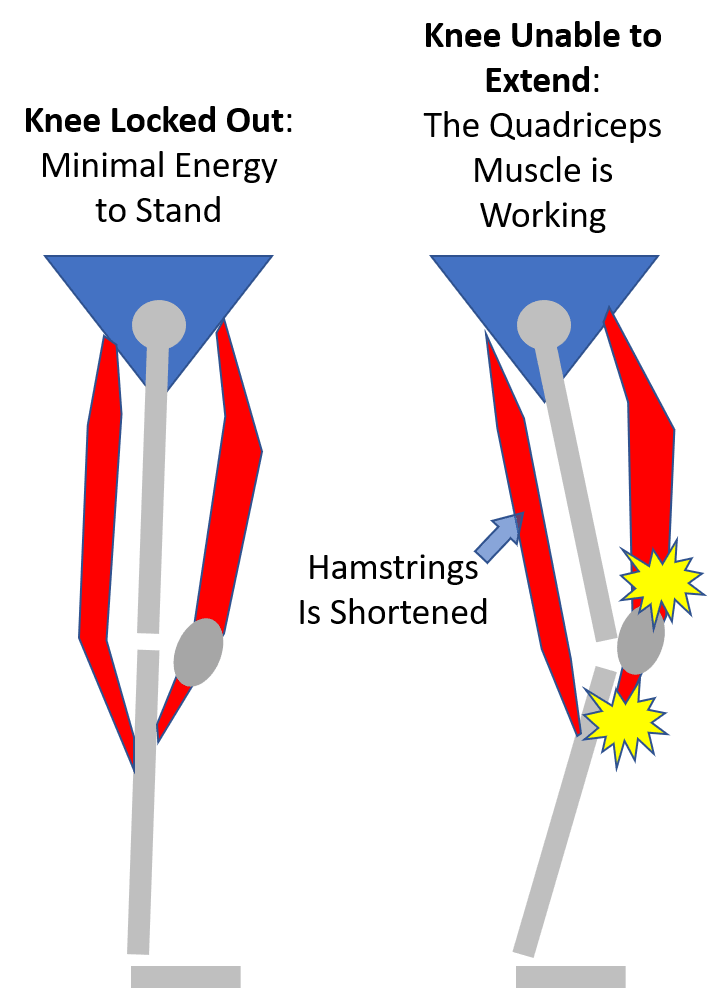Can’t Straighten Knee: Why Knee Extension Lag Matters
On this page:
- What happens when you can’t extend your knee?
- What are the possible causes?
- A patient example
- What are the treatments?
Most of us take for granted that we can fully straighten our knee. However, sometimes patients can’t do this and when that occurs, it’s a very big deal that usually causes other problems.
When the average person with normal knees stands, he or she can lock out the knees by slightly hyper-extending the joint. In that position, the thigh (quadriceps) muscles shut off and it takes very little energy to stand. This makes sense, as we were designed to stand for long periods without eating up precious calories.
What Happens When You Can’t Extend Your Knee?

When you can’t fully extend the knee, we doctors call that an “extension lag”. We also usually measure that in degrees. So 10 degrees of extension lag means that the knee is bent 10 degrees in flexion and won’t extend any further.
If you look at the images to the left, when standing with full knee extension, both the hamstrings muscles in the back and the quadriceps muscles in the front are, for the most part, shut off. However, when the knee won’t extend fully, the hamstrings are short and the quadriceps muscle is active. What does that cause?
Try standing right now and bending your knees slightly. What do you notice? First, not many of us can stand this way for long, as our thigh muscles will begin to burn.
Why? They are actively working to support your body, just like in the picture to the right above. Do that for any length of time and the quadriceps tendon, knee cap cartilage, and patellar tendon will begin to get too much wear and tear. Do it for months or years and those tendons will get torn up and the back knee cap will lose cartilage.
What Are the Possible Causes?
Knee extension lag can be caused by (1):
- Scarring of the joint capsule after knee arthroscopic surgery (aka arthrofibrosis)
- Chronic tightness in the hamstring muscle
- Bone spurs
- Torn and locking meniscus tissue
- A posterior cruciate ligament that is scarred or too tight
A Patient Example
I had a patient visit our licensed Grand Cayman clinic from the middle east whose one knee wouldn’t straighten fully. As I showed above, this was overloading and tearing up her quadriceps and patellar tendon. However, in her case, she reported that a massage therapist she knows could work her hamstrings and get the knee straight. I observed this as well, as when she was lying face up, her knee couldn’t straighten.
However, when lying face down, the knee had no issue straightening. Hence, the tightness in her hamstrings limiting knee extension is positional, meaning that the hamstrings aren’t scarred (a contracture), but just “freaking out” in one position. We are in the process of looking at all of the nerves that drive those hamstrings.
What Are the Treatments?
For the above patient, it’s figuring out what’s causing the hamstrings to go into over-drive. In another patient with arthrofibrosis, it would be breaking up the scarring caused by knee surgery.
Or it may be removing bone spurs in yet another patient. The point being, the focus needs to be on fixing the cause. In addition, the quadriceps and patellar tendon are often fried and damaged. Hence, these tendons need to be treated.
The upshot? Not being able to extend your knee is a big deal. Hence, figure out the cause and get it fixed as soon as possible!
__________________________________________________
References
(1) Sprague RB. Factors related to extension lag at the knee joint. J Orthop Sports Phys Ther. 1982;3(4):178-182. doi:10.2519/jospt.1982.3.4.178
If you have questions or comments about this blog post, please email us at [email protected]
NOTE: This blog post provides general information to help the reader better understand regenerative medicine, musculoskeletal health, and related subjects. All content provided in this blog, website, or any linked materials, including text, graphics, images, patient profiles, outcomes, and information, are not intended and should not be considered or used as a substitute for medical advice, diagnosis, or treatment. Please always consult with a professional and certified healthcare provider to discuss if a treatment is right for you.